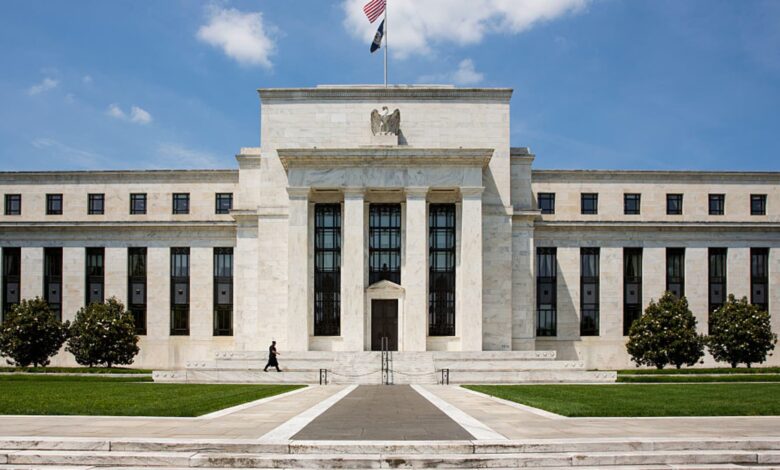A global bond sell-off is deepening as investors pare Fed rate cut expectations

The Eccles Building, location of the Board of Governors of the Federal Reserve System and of the Federal Open Market Committee.
Brooks Kraft | Getty Images
A sell-off in global bond markets is accelerating, fueling concerns over government finances and raising the specter of higher borrowing costs for consumers and businesses around the world.
Bond yields have mostly been rising globally with the U.S. 10-year Treasury yield touching a fresh 14-month high of 4.799% on Monday, as investors reassess the pace at which the Federal Reserve might lower interest rates.
In the UK, the 30-year gilt yields are hovering at their highest level since 1998, and the country’s 10-year yield recently hit levels not seen since 2008.
Japan, which has been striving to normalize it monetary policy after ending its negative interest rates regime early last year, has seen its 10-year government bond yield rise over 1%, hitting its highest in 13 years on Tuesday, LSEG data showed.
In Asia-Pacific, India’s 10-year bond yields rose the most in over a month on Monday and are near 2-month highs at 6.846%. Yields on New Zealand and Australia’s 10-year benchmark government bonds were also near two-month highs.
The only exception? China. The country’s bond market has been on a tear even as the authorities have sought to cool the rally. China’s 10-year bond yield plunged to a record low this month, prompting the country’s central bank to suspend its government bond purchases last Friday.
What’s going on?
Bonds have been rocked by a confluence of factors, market watchers told CNBC.
Investors are now anticipating fewer rate cuts from the Fed than they did previously, and are demanding to be adequately compensated for the risk of owning bonds that mature well into the future as they are concerned over large government budget deficits.
Last month, the Federal Reserve projected just two rate cuts in 2025, having previously indicated twice as many reductions. A hotter than expected U.S. jobs report on Friday has made the Fed’s rate-cut path more uncertain, analysts said. Nonfarm payrolls increased by 256,000 in December, surpassing the 212,000 added in November and exceeding the Dow Jones consensus forecast of 155,000.
The U.S. economy is strengthening faster than foreseen, which means the Federal Reserve has less or no room to cut interest rates, and the bond market is reflecting that, said Ben Emons, founder of FedWatch Advisors.
Bond yields typically rise when interest rates go up. Bond yields and prices move in opposite directions.
Bond investors are sending a clarion call to the world’s fiscal authorities to get a grip on their budget trajectories.
The chances of just a single cut this year increased after the jobs report, according to the CME Group’s FedWatch gauge.
“After [last week’s] employment report we are only pricing in somewhere between one and two rate cuts,” said Steve Sosnick, chief strategist at Interactive Brokers.
Additionally, elevated government deficits are also contributing to the bond sell-off as more debt supply is hitting the market.
The U.S. government reportedly recorded a deficit of $129 billion in December, 52% higher compared to a year ago. U.K. public sector net debt — excluding public sector banks — stands at over 98% of its GDP.
UK’s gilt markets are selling off even more for a similar combination of reasons, said CreditSights’ senior strategist Zachary Griffiths. “Primarily [it’s because of the] unease around the fiscal situation, but the drop in pound sterling is also stoking inflation concerns,” he added.
A ‘clarion call’ for governments
The implications of higher yields on governments and corporations are relatively simple, said Sosnick: “they’re not good!”
Higher yields ratchet up the amount of money needed to be spent on servicing debt, especially in the case of governments that run persistent deficits, analysts said.
Taken to an extreme, this is where “bond vigilantes” surface and demand higher rates to take on these large debts, said Sosnick.
“Bond investors are sending a clarion call to the world’s fiscal authorities to get a grip on their budget trajectories, lest they be subjected to additional wrath,” said Tony Crescenzi, an executive vice president at Pimco.
Rising U.S. yields also make it harder for some central banks to deliver rate cuts in the near term, HSBC’s chief Asia economist Frederic Neumann said on Monday, citing the Bank of Indonesia’s recent decision to keep interest rates on hold as one example.

U.S. 10 year yields in the past year
A broad depreciation across Asian currencies is also expected, said another HSBC analyst. The widening gap between the yields on government bonds in Asia relative to the U.S. is resulting in capital outflows from Asia as well as less inflows from the rest of the world into Asia.
It’s not just governments that are impacted by higher bond yields. The borrowing costs for many businesses are benchmarked to government bonds, and as government bond yields rise, so do the borrowing costs for companies.
As companies typically have to offer a higher yield than corresponding government bonds to attract investors, the burden on them is likely higher.
Potential ramifications include lower profit or foregone opportunities, said Sosnick, pointing to corporate bonds that generally have to offer higher rates than government debt.
Rising yields tighten borrowing costs, the dollar strengthens and equities tend to decline, affecting consumer confidence which then has a ripple effect in terms of housing and retail spending, said FedWatch Advisors’ Emons.
Bond buying ‘strike’
Market participants are now awaiting inauguration of U.S. President Donald Trump next week.
The “real test” comes once Trump takes office next week when a big wave of executive orders about tariffs and immigration restrictions are expected, industry watchers told CNBC.
Bond markets are witnessing a bit of a “buyer strike” at the moment, observed Dan Tobon, head of G10 FX Strategy at Citi.
“Because why take a leap of faith right now, when you’re going to have a lot more information in just a couple of weeks? And so that buyer strike means yields just keep moving up pretty aggressively,” he said.
“If those are perceived as being inflationary or having negative ramifications for the budget deficit, then the rout is likely to continue,” he added. Conversely, if the policies are relatively modest, bonds could stabilize or even reverse, he said.
https://image.cnbcfm.com/api/v1/image/104406547-GettyImages-541034976.jpg?v=1736829107&w=1920&h=1080
2025-01-14 03:00:53




